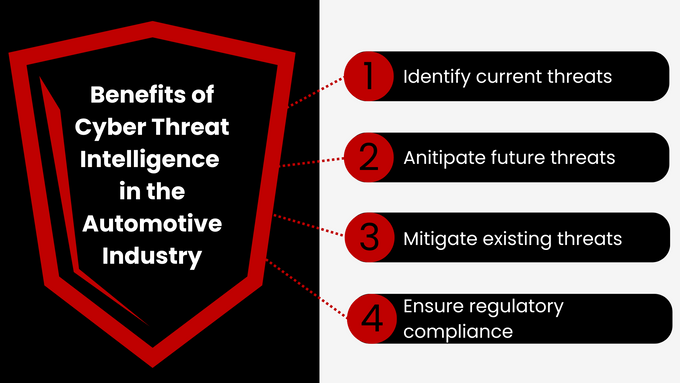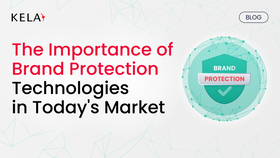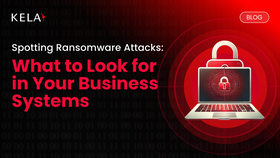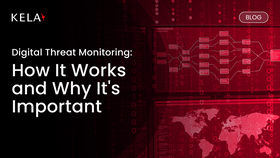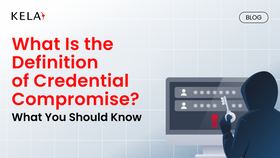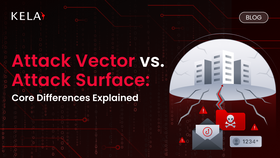Crucial Role of Cyber Threat Intelligence in the Automotive Industry
As vehicles become increasingly connected, the potential for cyberattacks grows exponentially, threatening not only consumer safety but also the integrity of entire automotive ecosystems. The integration of robust cyber threat intelligence is no longer a luxury, but a necessity for the automotive industry.
Published June 30, 2025
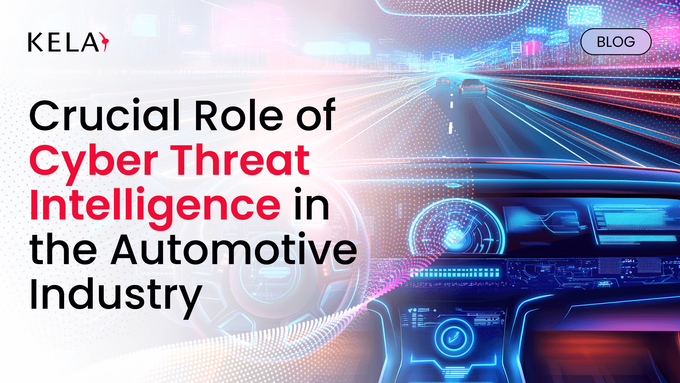
The automotive industry is going through a major change with the rise of connected and autonomous vehicles. This shift has made cybersecurity a top priority, as vehicles have become complex, software-driven systems with multiple points where cyberattacks could happen. Key players like manufacturers, suppliers, and regulators are aware of how essential cybersecurity is for ensuring vehicle safety, safeguarding consumer data, and maintaining brand reputation.
However, with technology advancing so quickly, the threat landscape is always changing, which means ongoing innovation and collaboration are necessary to stay ahead of cyber threats. This is why cyber threat intelligence (CTI) plays a crucial role protecting companies and customers in the automotive industry.
» Skip to the solution: Try KELA Cyber for free
Major Cybersecurity Challenges Faced by the Automotive Industry
Cyberattacks on vehicles can have serious safety implications, potentially leading to loss of control, system failures, or even accidents. This makes automotive cybersecurity a matter of life and death, requiring a higher level of security than many other industries due to the following challenges:
- Vehicle software vulnerabilities: Weaknesses in the software of electronic control units (ECUs) can be exploited, allowing unauthorized access to vehicle functions.
- Communication system attacks: Attacks on systems like the CAN (controller area network) bus can disrupt essential functions or manipulate sensor information. Connectivity features, such as internet access, Bluetooth, and cellular connections, open up new avenues for remote attacks.
- Data breaches: Sensitive information stored in vehicles or linked services is at risk of theft, which can lead to privacy issues and financial losses.
- Supply chain risks: The automotive supply chain is complex, involving numerous suppliers and manufacturers. Vulnerabilities in third-parties or any part of the supply chain can compromise the security of the entire vehicle.
- Manufacturing infrastructure attacks: Attacks on manufacturing infrastructure can halt production, affect quality control, and even introduce vulnerabilities into vehicles.
- Lack of skilled professionals: There's a shortage of cybersecurity experts with automotive knowledge, which makes it difficult to develop and implement effective security strategies.
- Regulatory pressures: Governments around the world are increasing regulations around automotive cybersecurity. This adds pressure to automotive manufacturers to implement strong cybersecurity measures.
» Learn more: Cyber threats in the automotive sector
Why Cybersecurity in the Automotive Industry Is So Difficult to Maintain
- Increased complexity and connectivity: Modern vehicles are essentially "computers on wheels," with numerous electronic control units (ECUs) managing various functions. This complexity creates a larger attack surface for cybercriminals.
- Long vehicle lifespan: Unlike smartphones or computers, vehicles have a long lifespan, often lasting 10-15 years or more. This means that cybersecurity measures must remain effective over an extended period, requiring ongoing updates and maintenance. Older vehicles may lack the necessary hardware or software to support modern security protocols.
- Distributed systems: Vehicles operate in a distributed way, often without constant internet connection. This makes it difficult to provide real time monitoring and cybersecurity responses.
» Need more help? Here's everything you need to know about infostealers
How Cyber Threat Intelligence Addresses Risks in the Automotive Industry
In the context of the automotive industry, cyber threat intelligence involves the collection, analysis, and dissemination of information about potential or existing cyber threats that target vehicles, related systems, and infrastructure.
It is crucial for the automotive industry by helping companies do the following:
» Understand the role of a threat intelligence analyst
1. Identify Current Threats
Effective cyber threat intelligence has the following features crucial for identifying current threats in the automotive industry:
- Real-time threat detection: Threat intelligence feeds give immediate alerts about ongoing attacks and suspicious activities affecting the automotive industry. This quick response capability helps contain potential breaches and lessen their impact.
- Vulnerability identification: Threat intelligence pinpoints specific vulnerabilities in vehicle software, communication systems, and manufacturing processes, enabling focused patching and remediation efforts to lower the risk of exploitation.
- Attacker attribution: Threat intelligence helps link attacks to particular threat actors or groups, shedding light on their motivations, capabilities, and tactics. This information supports better defense strategies and cooperation with law enforcement.
2. Anticipate Future Threats
Threat intelligence gathers insights from various sources like the Dark Web, vulnerability databases, and security experts to spot new threats and vulnerabilities that matter to the automotive sector. This helps manufacturers and suppliers stay ahead of potential attacks and tackle weaknesses in their systems using these strategies:
- Predictive analysis: By looking at past attack patterns, threat intelligence can help forecast future attack methods and likely targets within the automotive ecosystem.
- Scenario planning: Threat intelligence aids in scenario planning, allowing stakeholders to simulate possible cyberattacks and assess how effective their security measures are. This process helps highlight any defense gaps and boosts readiness for incidents.
3. Mitigate Existing Threats
Threat intelligence guides proactive security actions, such as enhancing authentication processes, deploying intrusion detection systems, and segmenting networks to minimize the effects of potential breaches:
- Vulnerability remediation: By identifying specific vulnerabilities, threat intelligence directs remediation efforts, allowing for timely patching and software updates to fix security issues before they can be exploited.
- Incident response: Threat intelligence bolsters incident response by providing context and insights into attacker tactics, enabling quicker and more effective containment, eradication, and recovery from cyberattacks.
- Collaboration and information sharing: Threat intelligence promotes collaboration and information sharing among stakeholders in the automotive industry, creating a united front against cyber threats.
4. Ensure Regulatory Compliance
Threat intelligence is essential for helping organizations comply with automotive cybersecurity regulations and standards like UNECE WP.29 and ISO/SAE 21434. By providing insights into current threats and vulnerabilities, companies can:
- Spot and fix security gaps: Threat intelligence helps identify vulnerabilities and threats specific to the regulations, allowing organizations to address these gaps and maintain compliance.
- Put effective security measures in place: Intelligence guides the selection and implementation of the right security controls, ensuring they align with standard requirements.
- Show compliance: Keeping documented threat intelligence can act as proof of proactive risk management and compliance efforts.
- Stay informed about changing requirements: Threat intelligence keeps organizations updated on evolving threats and regulatory changes, supporting ongoing compliance.
» Not convinced? Here are some more reasons you need cyber threat intelligence
Primary Sources of Threat Intelligence in the Automotive Industry
- Automotive industry databases: Databases such as the Automotive ISAC contain specific vulnerabilities and incidents related to automotive components and systems. They often provide detailed information about known exploits, affected vehicle models, and potential impacts.
- Dark Web and cybercrime forums: These sources reveal emerging threats, discussions about new attack techniques, and the sale of stolen automotive data or hacking tools. They provide early warnings of potential attacks and insights into the motivations of cybercriminals targeting the automotive sector.
- Social media: Social media platforms can reveal discussions about vehicle vulnerabilities, user experiences with security issues, and the spread of malware or phishing campaigns targeting automotive users. They can also provide insights into public sentiment regarding automotive cybersecurity.
- Regulatory and standardization bodies: These bodies include UNECE and ISO/SAE 21434 and provide information on cybersecurity regulations, standards, and best practices for the automotive industry. They offer guidance on compliance requirements and help organizations stay up-to-date on evolving cybersecurity threats.
- Threat intelligence groups and security vendor reports: These sources provide expert analysis of emerging threats, vulnerability assessments, and recommendations for security measures. They offer in-depth insights into the tactics, techniques, and procedures (TTPs) of cybercriminals targeting the automotive industry.
Best Practices for Improving Cybersecurity Posture in the Automotive Industry
Ensure that key cybersecurity aspects are implemented at every stage of vehicle development, from the initial design all the way through to manufacturing and post-production updates. Taking this proactive route helps reduce vulnerabilities and creates a solid security base.
Key techniques include:
- Collaboration and information sharing: Encourage teamwork with suppliers, security researchers, and industry groups to exchange threat intelligence and best practices. This collaborative effort boosts the overall cybersecurity strength of the automotive sector.
- Continuous monitoring and vulnerability management: Set up ongoing monitoring for vehicle systems and networks to spot and address threats as they happen. Develop a strong vulnerability management program to quickly identify, evaluate, and fix any vulnerabilities.
- Employee training and awareness: Provide training for employees on cybersecurity threats and best practices to help prevent social engineering attacks like phishing and foster a culture that prioritizes security. Ensure all employees know what their roles and responsibilities are in case of a threat.
» Make sure you're preparing for the future of cybercrime
Take Control of Automotive Cybersecurity Today
The integration of robust cyber threat intelligence is no longer a luxury, but a necessity for the automotive industry. As vehicles become increasingly connected, the potential for cyberattacks grows exponentially, threatening not only consumer safety but also the integrity of entire automotive ecosystems.
Leveraging comprehensive cyber threat intelligence platforms like KELA's Threat Actors Hub empowers companies to move from a reactive to a proactive security posture. By gaining actionable insights into the latest threats and vulnerabilities, automotive companies can effectively identify, neutralize, and mitigate cyber risks as they appear.
» Ready to begin? Contact us or try KELA for free

